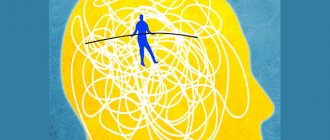In this article
- Key Features
- Symptoms
- An example of fur coat schizophrenia
- Malignant fur coat-like schizophrenia
- Schizoaffective disorder
- Paranoid fur coat-like schizophrenia
- Kandinsky-Clerambault syndrome
- Interpretive nonsense
- Acute hallucinosis
- Causes
- Treatment and prevention
- Forecast
Fur-like schizophrenia is not a specific diagnosis. This is the name of one of the features of the course of this psychiatric disease. It occurs quite often - in about one person out of a hundred. But it has a lot of forms and varieties. At the same time, its study occurs constantly, and therefore science and medicine learn more and more about it every year. Let's tell you more about fur coat-like schizophrenia.
Key Features
The furry course of schizophrenia can be characteristic of any of its varieties. The key feature of this psychiatric disease is the suddenness of the attacks. A person may look completely healthy, but suddenly begin to experience delusions, hallucinations, and other signs of schizophrenia.
An attack can last for several days or years, but sooner or later it passes as suddenly as it appeared. After this, a remission phase begins, the duration of which is also quite difficult to predict. A new attack can occur as a result of any factor that in a normal situation would seem insignificant to both the patient and others.
Fur-like schizophrenia occurs most often in practice (more than 50% of cases). Moreover, there are many types of this pathology, which occur precisely in the form of attacks.
The term “fur coat-like schizophrenia” (fur coat) is not scientific or medical. It is used for ease of communication with a clinic patient (Schub (“fur coat”) from German “shift”). According to the ICD, this pathology is called paroxysmal-progressive. The second part of the term means that with each attack the symptoms become more and more severe.
Symptoms
Symptoms of fur coat schizophrenia are divided into two groups - positive and negative. The first indicate the activity of the psyche, although it does not work “correctly.” Among them:
- Manic syndrome
- Rave
- Hallucinations
- Obsessive ideas and thoughts
The easiest way to recognize schizophrenia is by these signs. However, they can also be more destructive, as they affect the individual. This is called a schizophrenic defect.
Negative symptoms are so nonspecific that they make diagnosis very difficult. The patient has:
- Emotionality
- Speech disorders
- Apathy
- Anhedonia
- Muscle hypotonia
- Decreased willpower
It is very difficult to recognize schizophrenia by these signs, and that is why it is not always possible to start treatment on time. But in most cases, positive symptoms make themselves known.
An example of fur coat schizophrenia
As a rule, fur coat-like schizophrenia is detected in withdrawn people. The first signs that a person is prone to this pathology appear in early childhood. He develops according to the type of schizoid personality, characterized by emotional indifference, a tendency to loneliness and apathy. Subsequently, depression, weak will, demonstrativeness, outbursts of aggression and frequent nervousness are observed.
Immediately before the attack, the person does not notice any changes. He has some anxiety, unfounded concern, but in general, he lives his normal life. There is also apathy and lack of interest in others, pleasures and food.
At some point, delusions and obsessive thoughts appear that are associated with new ideas, persecution, delusions of grandeur, etc. The patient begins to talk a lot and philosophize. In this case, there is more behavioral arousal, manifested in gestures and great activity, rather than intellectual activity. The person does not realize that he is delusional.
For example, the patient thought that he had invented something brilliant. He begins to devote more time to this, often talks about it, studies it, forgetting about sleep and food. Gradually he develops paranoia. It seems to him that his neighbors are speaking silently, that the special services are hunting for him, etc. He is also beginning to be disturbed by hallucinations, usually auditory (“voices”).
Usually these signs are enough for others to suspect a disorder and seek medical help. Sometimes the attack goes away on its own after a few weeks, but it can also drag on. If you start treatment with medications, you can quickly stop the symptoms. The person becomes “normal” without any consequences for the personality and psyche. But this depends on the type of schizophrenia and the timeliness of the prescribed treatment.
Psychotherapy for paranoid schizophrenia
Psychiatric care for paranoid schizophrenia is not limited to taking medications. A psychotherapist works with them, helping to speed up the onset of the “light” period and prolong remission. The positive result of complex treatment affects patients with the initial stages of the pathology and with a sluggish form of the disease. Psychotherapy is not indicated for the following situations and disorders:
- acute state of psychosis;
- the last stage of schizophrenia with the formation of a defect;
- significant decrease in intellectual abilities;
- severe anxiety;
- high disinhibition of drives;
- lack of control over one's behavior;
- categorical reluctance to undergo therapy.
Mandatory conditions for the use of psychotherapy are:
- relief of an acute condition with the help of medications;
- established contact between the patient and the doctor;
- absence on the part of the patient of the likelihood of causing harm to others.
The work of a psychologist with patients with paranoid schizophrenia is based primarily on an educational type, when the specialist’s conversation takes the form of a seminar with elements of training on social adaptation. In it, he gives detailed information about the disease for its proper understanding by the patient. This allows him to take control and recognize the first manifestations in advance.
The work with the patient begins with a psychiatrist, who takes on the theoretical part. At the same time, he talks about the cause, course, and prognosis of paranoid schizophrenia, describes the individual characteristics of the patient in the light of the current situation, as well as the need and role of taking medications to relieve unwanted manifestations of mental disorder. The same work is carried out with the patient’s relatives. Information is presented in the form of unambiguous and understandable information, with the active involvement of listeners and answers to their questions.
This work allows you to obtain the following results:
- the emergence of positive dynamics in the clinical course of the disease;
- reduction in the activity of psychopathological disorders;
- reducing the frequency and duration of hospital stay for patients;
- possibility of integration into society;
- doing feasible work.
Cognitive behavioral therapy
To improve the patient's condition, adaptive treatment methods are used, most often cognitive-behavioral psychotherapy is used. It is most suitable for helping with paranoid schizophrenia, as it successfully acts on its main manifestations:
- systematic delirium;
- feeling of panic, anxiety;
- manic symptoms;
- obsessive (ritual) movements and actions;
- super valuable ideas.
As a result of successful treatment, the patient develops a critical attitude towards his delusional ideas. He begins to calmly perceive and realize his illness, the need to take medications and follow the doctor’s instructions. Many people manage to learn to control affective states. Cognitive behavioral therapy helps a family person establish normal relationships with a partner.
Psychoanalytic method
Psychoanalysis is suitable for the initial stages of paranoid schizophrenia, when a person retains intelligence and has a strong desire to overcome the disease. The method involves individual communication between a specialist and a patient over several sessions. The doctor asks questions that the person must answer as honestly as possible. After this, the psychotherapist will be able to identify the patient’s personality traits and help him work with the subconscious, teaching him to take control. This to a large extent makes it possible to prolong remission, since a person can promptly identify potential triggers and avoid their influence.
As a result of this work, a person learns to understand his own condition, avoid stressful situations, work through delusions and hallucinations, distinguish the productive symptoms of his illness from reality, and effectively carry out social interaction.
Malignant fur coat-like schizophrenia
Malignant schizophrenia begins as a fur-like disorder, that is, it consists of alternating attacks and remissions. But later the pathology becomes persistent. A schizophrenic defect is observed. There is a possibility of death.
First, a person’s mood disappears and his overall energy potential decreases, which is accompanied by inactivity. The patient does not want to do anything, is not interested in anything, and shows less and less emotion. But this is only the period preceding the attack.
The disease itself begins with hypomania, a condition that is similar to mania, but not as pronounced. Euphoria periodically increases, the person behaves foolishly. There is hostility towards loved ones and others. Symptoms of subdepression are observed when the patient becomes lethargic and irritable, and often thinks about death and suicide.
In general, the symptoms are very severe. To one degree or another, the following signs of the course of malignant fur coat-like schizophrenia may be observed:
- Delusions and hallucinations. Pseudohallucinations are possible when the patient does not identify visible or audible objects with real ones
- Catatonia is a type of movement disorder. There can be both stupor and excitement
- Paranoid syndrome. The patient is delusional, draws various conclusions that have no basis, provides contradictory evidence, etc. All this is interspersed with hallucinations
- Oneiric syndrome is a clouding of consciousness with an influx of fantastic hallucinations that mix with reality, and sometimes simply displace it
- Mutism is a painful condition in which a person cannot answer questions and does not even let others know that he is ready to contact them.
Along with these symptoms, bullous dermatitis, toxicosis and elevated body temperature are observed. The disease requires emergency hospitalization. Over the years, the attacks will be longer and longer, and the remissions will be short, until delusions and hallucinations completely displace the “healthy” personality.
Often this form of pathology occurs in adolescence and young adulthood. In severe cases, drug therapy does not produce any results. The patient may die.
Unlike juvenile schizophrenia (also a rather complex disease), malignant fur coat is manifested by the patient’s ability to realize his altered state. He has the opportunity to contact others and perform simple work activities.
Symptoms of mental illness
Signs of schizophrenia are conventionally classified into negative and positive. The first include symptoms that fall outside the patient’s psyche, that is, they act as the basic core of the disorder. This is a decrease in volitional qualities, loss of interest in what is happening, disappointment, apathy, autistic behavior.
Positive signs are those that are added additionally and make the clinical picture more vivid. Doctors explain their appearance by excess dopamine and increased stimulation of dopamine receptors. This includes delusions, auditory hallucinations, problems with speech, thinking, movement, and crazy obsessions.
Description of negative (deficit) symptoms
Negative symptoms characterize a deficiency of certain mental functions. The patient loses emotional connection with close relatives and friends. He is constantly in a bad mood. He is not able to rejoice at anything, he is sad.
At the same time, the severity of emotional disturbances can vary - from mild melancholy to deep depression. Gradually, the schizophrenic exhibits notes of autistic behavior. He thinks only about himself and is closed to communication. If the first signs of schizophrenia occurred in adolescence, the child will most likely stop attending all clubs. He will retire at home for a long time and refuse to perform his daily duties. The range of his interests is significantly narrowed.
As for volitional disorders related to negative symptoms, they manifest themselves in the form of hypo- or hyperbulia - in a decrease or increase in appetite/libido, respectively. At the same time, the need to sleep and rest more disappears.
Most often, schizophrenics suffer from hypobulia. All their physiological needs are reduced to a minimum. They refuse to eat, do not want to shower, do not pay attention to what they are wearing, and lose interest in intimate relationships.
Drifting is a symptom of the schizophrenic's increasing passivity. It is characterized by the inability to make decisions independently. A schizophrenic obeys the opinion of the majority and never expresses his thoughts. He easily copies other people's actions, even if they are punishable by law.
During the period of dominance of drift symptoms, the patient’s appearance also changes. His facial expressions become inadequate and often do not correspond to the prevailing circumstances.
Positive symptoms of schizophrenia
In schizophrenia, auditory hallucinations occur. This means that the patient hears voices that do not exist. They can be:
- threatening (they give information that they are planning to kill a person);
- commentators (explain the actions of a schizophrenic, make various comments to him);
- imperative (order to do something, for example, commit suicide);
- antagonistic (the patient simultaneously hears a bad and a good voice, can listen to them argue with each other for a long time).
Most schizophrenics evaluate hallucinations as an obstacle to normal life, interference in fate from the outside, and therefore begin to actively resist them. This is where delusional ideas come from - judgments that cannot be dissuaded.
To distinguish the delusions of a schizophrenic from the self-righteousness of a healthy person, you need to understand whether the words of the former are connected with personal experience. There is never any logical evidence for nonsense. It is conventionally divided into:
- delusion of influence (the patient thinks that someone is constantly influencing him badly, fears witches and sorcerers);
- delirium consequences (the patient is sure that someone is watching him);
- delusions of jealousy (looking for evidence that a loved one is cheating on him);
- delusions of grandeur (the schizophrenic is convinced that he is the best representative of humanity);
- delirium of self-blame (the patient thinks that he is harming everyone, that people are dying precisely because of him);
- dysmorphophobic delirium (the patient is sure that he has a noticeable physical defect, for example, excess weight, while he is completely thin);
- hypochondriacal delusion (the patient believes that he has a fatal disease from which he cannot be cured).
Obsessive ideas in schizophrenics arise against their will. So, they can spend all day thinking about what would happen if the Earth exploded, tirelessly multiplying numbers, and thinking about death. Appearing suddenly, obsessive ideas greatly upset the patient, but he is not able to forget about them.
Fruitless philosophizing also has a negative impact on the patient’s communication with other people. At the same time, the patient does not care at all what the listener thinks about him - he is busy only with himself.
Movement disorders, also related to positive symptoms, are active movement or stupor. They are often aggressive in nature. What’s interesting is that stupor can be different:
- “waxy flexibility” - a schizophrenic forcibly maintains one body position for a long time. For example, he may sit on a chair with his hands on an imaginary table in front of him. In fact, they hang in the air;
- with numbness. The patient is in the fetal position.
Schizophrenics in a state of stupor do not react to anything, do not speak, or answer questions in a whisper.
If you experience similar symptoms, consult your doctor
. It is easier to prevent a disease than to deal with the consequences.
Schizoaffective disorder
In this case, the signs of schizophrenia are combined with symptoms of an affective disorder, in which the emotional state changes towards depression or elevation. It occurs in the form of attacks with a gradual increase in symptoms, including mania, delirium, depression and paranoid syndrome.
It is quite difficult to describe all the symptoms, since the pathology combines many signs between bipolar disorder and typical schizophrenia. In many ways, this complicates diagnosis and treatment. But, as a rule, this disease is characterized by a more favorable course, which depends on how early it appeared. The earlier, the more severe the personality defect.
In general, the disease is amenable to drug therapy, and is a little more difficult to treat than bipolar disorder, but somewhat simpler than classic schizophrenia.
Modern view of schizophrenia
The view of schizophrenia as a gradually and continuously progressive disease, inevitably leading to an emotional-volitional defect, is currently not confirmed by world practice. There are documented cases of spontaneous and complete recovery, in particular, described in the books of Barbara O'Brien ("An Extraordinary Journey into Madness and Back: Operators and Things") and Arnhild Lauweng ("The Next Day I Was Always a Lion").
However, today schizophrenia is still one of the most disabling diseases, second only to complete paralysis and dementia.
In Soviet times, the so-called sluggish schizophrenia (in its neurosis-like and psychopath-like forms) was distinguished separately. Currently, this form has been removed from the International Classification of Diseases (ICD 10), and such a diagnosis no longer exists.
Schizophrenia in all its manifestations is treated by a psychiatrist. During active treatment, as well as in its maintenance stage, adaptive support work with a psychologist and psychotherapist is possible and important.
If someone close to you experiences strange or inappropriate behavior, consult a psychiatrist. Also read here.
Consultation with a doctor, appointment with a psychologist:
Telephone
All materials on the site are presented for informational purposes only, approved by certified physician Mikhail Vasiliev, diploma series 064834, in accordance with license No. LO-77-005297 dated September 17, 2012, by a certified specialist in the field of psychiatry, certificate number 0177241425770.
Paranoid fur coat-like schizophrenia
One of the most diverse forms of symptoms in terms of the number of symptoms is fur-like schizophrenia. The attack is preceded by negative symptoms, when the patient loses interest in everything, and his energy potential noticeably decreases. Positive signs are characteristic of attacks. Delusions and hallucinations dominate, more often “voices.” As it progresses, other symptoms appear:
- Paranoid syndrome. Delirium is characterized by a clear structure. The patient substantiates his delusional ideas in the smallest detail, building logical chains. Moreover, this can only concern a certain topic. Otherwise the person appears and acts normally. This syndrome is often observed in men.
- Paranoid syndrome. In this case, the structure of delirium is less systematized. New personalities, more and more events and details appear in the patient’s stories. Those around you can become part of the plot of the patient’s delusional experiences.
- Paraphrenic syndrome is a complex of symptoms in which a person sees fantastic hallucinations of grandiose proportions. This is combined with delusions of grandeur and persecution. In such cases, patients feel like “Napoleons” and other famous personalities.
Anxiety gradually increases. Patients complain of various abusive calls, comments in the head, orders, etc. The development of acute Kandinsky-Clerambault syndrome is possible.
Attack period
The clinical picture of the attack phase of the disorder is very diverse.
It is distinguished by the presence of psychopathic, depersonalization, hallucinatory, delusional and other syndromes. The depressive signs of the psychotic phase of the disease are characterized by lethargy, decreased activity, but without a feeling of melancholy. There is a depressed, gloomy mood, aggressiveness, and hostility towards others. Patients are irritable and have outbursts of anger. Hypochondriacal thoughts are also characteristic.
Often, against the background of depression, a paranoid syndrome develops, manifested by delusions of various directions: persecution, poisoning, greatness, relationships, special purpose. The patient shows excessive suspicion and distrust towards those around him. There is no critical attitude towards delirium. Severe thinking disorders are observed.
Manic episodes are also common in this form of schizophrenia. Characterized by more motor rather than intellectual excitement. Typically speech agitation, fruitless philosophizing.
The phenomena of depersonalization are associated with a feeling of one’s own change. They arise against the background of erased depression. Accompanied by a change in perception of the surrounding world, isolation, and decreased activity.
A 13-year-old patient describes her condition: “I began to clearly feel changes in myself, not happening abruptly, but gradually. It wasn't depression. I don’t even know if this is a disease or normal. Inexplicable depression appeared and there was no desire to do anything. I wanted solitude, to be alone with my thoughts. I talked a lot about death and suffering.” The girl justified the changes in her sense of self as adolescence, which is accompanied by a change in values and priorities.
Psychopathic-like disorders are more characteristic of adolescence and are called heboid. Typical traits are rudeness, irritability and opposition to control. There is a marked decrease in volitional activity. While maintaining intellectual abilities, patients lose the ability to learn and work. Metaphysical intoxication is characteristic - useless reasoning on high, philosophical topics. Self-control is impaired, which often provokes sexual liberation, alcohol and drug addiction.
It should be noted that there is no withdrawal syndrome in schizophrenic patients with addictions. When the schizophrenic furnace lasts for years, patients receive a persistent moral and emotional personality defect. However, with age, psychopathic manifestations smooth out, leaving a slight infantile effect. Patients become able to master certain professions and start a family.
More severe forms of the disease are accompanied by pronounced Kandinsky-Clerambault syndrome and catatonic-hebephrenic phenomena.
Kandinsky-Clerambault syndrome is distinguished, first of all, by delusions of physical influence, as well as mental automatisms, manifested by a feeling of unnaturalness, alienness of one’s own actions, thoughts, and sensations.
Catatonic-hebephrenic symptoms mark a particularly severe course of the disease. Hebephrenia is manifested by motor agitation, foolishness, stereotypies, and importunity. Patients make chaotic, pretentious, impulsive movements. They are verbose, but their speech is characterized by incoherence and incomprehensibility. Shout out individual phrases or words.
Excitement is replaced by a catatonic stupor, accompanied by typical manifestations: waxy flexibility, silence, immobility, negativism.
A 25-year-old girl was admitted to the department of a psychiatric hospital. The patient's condition is characterized by a sharp change in mood: she sometimes cries, sometimes laughs, and is polite to the doctors. Doesn't respect subordination. Declares his love to all males, including patients. Expresses persistent thoughts of suicide because no one loves her. After therapy she was discharged.
A year later he is re-admitted to the department. I took 50 tablets of diphenhydramine: this is what Mayakovsky’s voice ordered, having the best intentions. The poet visited the sick room with Yesenin and Tsvetaeva. Together they discussed suicide. The patient talks about the meaninglessness of life. There is no self-criticism. She wanted to commit suicide in the manner of Tsvetaeva, adhering to the principle of the last straw.
Kandinsky-Clerambault syndrome
With this syndrome, patients feel that their thoughts, feelings or actions belong to other individuals. It’s as if it’s not them who speak or move their hand, but another person who does it.
Such symptoms are called automatisms. There can be several types:
- Ideatorial (associative). Characterized by the belief that a person’s thinking is influenced by someone else. One of the common variants of this automatism is mentism, in which a person cannot control ideas and memories. It seems to him that they are involuntary. Sometimes there is a syndrome of openness, when the patient believes that all his thoughts are known to those around him, who discuss him in secret. The same group of automatisms should include unintelligible noises, internal monologues and sentences, disappearance of ideas and memories, etc.
- Sensory (senestopathic). The patient develops painful sensations of a somatic nature. He becomes either hot or cold, and pain occurs in the limbs or internal organs. The main thing is that it seems to the patient that all these symptoms are a consequence of the influence of extraneous forces on him. There are sensations of pulsation, twisting, squeezing, bursting, etc.
- Motor (kinesthetic). The patient believes that all his movements are performed not by himself, but by some other person. It “forces” a person to move, speak, and perform certain actions. Feelings of numbness and paralysis are possible.
The described automatisms, as a rule, develop in exactly this sequence. First, ideomotor ones appear, then sensory ones, and then motor ones.
Interpretive nonsense
Interpretive delusion, along with the syndrome described above, is one of the types of exacerbations of the paranoid course of fur-like schizophrenia. Delusional thoughts and ideas can haunt a person for years, but before an exacerbation, a person experiences anxiety for no reason and sudden mood swings. In the acute phase, there may be automatisms and hallucinations - auditory, visual and olfactory. Other signs of interpretive delusion are:
- Sustained systematized delirium
- Delusional thoughts are associated with persecution, jealousy, invention and physical abuse
- From the outside, personal changes become noticeable
- Inappropriate facial reactions (or their complete absence)
The patient's professional skills do not suffer, and his memory does not fail. However, thinking is impaired, which prevents full-fledged work activity.
Acute hallucinosis
Acute hallucinosis is another variant of exacerbation of paranoid schizophrenia. Symptoms are very varied:
- Verbal illusions
- "Other people's speeches" in my head
- Classic hallucinations
- Internal dialogues that the patient listens to from the outside
- Multiple voices
- Mental automatisms, etc.
With further progression of the pathology, paraphrenia develops, which is accompanied by fantastic hallucinations. The patient may believe that he has superpowers and can influence other people or the world around him with their help.
The degree of personality changes in the paranoid type of fur coat-shaped schizophrenia can be different. In any case, the treatment will be difficult and lengthy.
Causes of the disease
The main cause of any type of schizophrenia is hereditary predisposition, mutations of fetal genes during intrauterine development, hypoxia. Cases of the occurrence of the disease in families where mental disorders are not observed in relatives are described. The pathogenesis of the disease is still being studied, but it is already reliably known that patients with this diagnosis have very high levels of dopamine.
Compounded heredity allows us to talk only about the possibility of a mental disorder. The first symptoms of the pathology are observed after exposure to provoking factors, namely:
- taking psychotropic substances;
- alcohol abuse;
- psycho-emotional overload;
- brain injuries;
- infectious diseases;
- early parental abuse;
- individual personality characteristics.
Most often, paranoid schizophrenia affects people who are prone to irritation by nature, intolerant of others, and suspicious of others. Often the trigger for the disease is alcoholism or drug addiction, since ethanol and psychoactive substances greatly affect the activity and production of neurotransmitters in the brain. The main idea of delirium in this mental disorder is often an experience that a person encountered in the past and could not let go of.
Causes
The causes of any form of schizophrenia, as an object of study, remain open. Doctors and scientists talk about predisposing factors, including intrauterine anomalies, drug addiction, alcoholism, congenital diseases of the central nervous system and genetic predisposition. But the exact causes and mechanism of development of schizophrenia are still unknown to science.
Pathology is detected in both men and women, but in the latter, symptoms usually appear 6 years later. The main symptoms are observed between the ages of 20 and 30 years.
Risk group
People at greatest risk of developing schizophrenia are:
- with a genetic predisposition;
- with structural abnormalities in brain tissue responsible for personal characteristics, emotions, thinking;
- staying in a state of stress and depression for a long time.
Schizophrenia can worsen:
- after an infectious disease;
- after discontinuation of medications;
- as a result of past pathologies of the cardiovascular system/kidney/respiratory system;
- due to stress.
Treatment and prevention
Treatment is determined by the form and nature of the pathology. If schizophrenia is sluggish, then the patient is prescribed tranquilizers, as well as psychotherapeutic methods. The duration of drug therapy is at least 7-8 months. The need for hospital stay is determined by the general condition of the patient. If he does not pose a danger to himself or others, treatment can be outpatient.
In the presence of unpleasant bodily sensations (senestopathies), neuroleptics in small dosages and antipsychotic drugs are additionally prescribed. With a malignant course, psychotropic substances are required. It is important to eliminate delirium and other symptoms so that the pathology does not worsen.
As noted, fur coat-like schizophrenia is characterized by attacks and remissions. Treatment, which in this case will act as a prevention of exacerbations, is also necessary during the “calm” period. Usually one or another type of long-acting medication is prescribed. In case of drug resistance, a sharp refusal of drug therapy is used, followed by a sharp prescription.
In addition to drug treatment, psychotherapy, including family therapy, is important. The patient’s relatives must understand what to say to a schizophrenic, how to communicate with him, work, etc. The main task is to develop in the patient an understanding that he is sick. After this, it will be easier to prevent personal destruction and incapacity.
In general, psychotherapists use various methods aimed at solving 3 types of problems:
- Social adaptation
- Formation of acceptable behavior
- Developing an adequate perception of pathology
If we talk about specific prevention of schizophrenia for those who are not diagnosed with it, then it does not exist. People just need to have a rough idea of the risks and know whether they have a genetic predisposition to such pathologies. If one of the relatives suffered from schizophrenia, then the likelihood of developing various psychiatric disorders in children is quite high. Provoking factors such as alcohol, drugs, etc. should be excluded.
Characteristics of the disorder
Schizophrenia takes its name from the German word schub, which means “shift.” We are talking about a personal shift, a developmental turning point that is irreversible. A persistent mental defect is formed, causing gross distortion of the personality.
Paroxysmal-progressive or fur coat-like schizophrenia is characterized by alternating attack periods with remission phases. The duration and severity of symptoms in both phases depends on the form of the disorder, as well as the stage of the disease.
Attacks or fur coats can be marked by a sudden, acute development, appearing over several days, or have a subacute course, when symptoms increase over several weeks. The attack lasts from several weeks to several months.
Remissions have varying degrees of severity. The first psychotic attack, as a rule, ends in complete remission, without defective traces. The patient retains a critical attitude towards the behavior and experiences suffered during psychosis, or forgets its picture completely. However, as the course of remission progresses, it loses its benign quality and becomes incomplete, expressing persistent personal changes.
Usually the defect appears clearly after 3-4 psychotic attacks. The duration of remission ranges from several weeks to several years. Their quality is influenced by the therapy applied to the disorder. Interruption of treatment leads to a reduction in remissions and an increase in the intensity and duration of psychosis.
With the increase in personal shift, the course of the disease changes, more reminiscent of a continuously flowing form with attack periods. Continuity is determined by the presence, even during the interictal, remission, period of negative symptoms of schizophrenia: lethargy, apathy, physical inactivity, emotional coldness, isolation, thinking disorders, with the appearance of bright psychotic outbursts against their background.
This form of the disorder is considered the most common among all existing schizophrenic types. The outcome of the disease is ambiguous. In the case of a malignant course, the patient’s psychotic defect rapidly increases, causing the formation of schizophrenic dementia. The clinical picture, similar to the sluggish form, provokes the emergence of a shallow disintegration of the personality. More often, an intermediate state between two extreme options is formed.
Forecast
It is impossible to accurately predict the development of fur coat-like schizophrenia. There are long-term remissions, but prolonged attacks are also diagnosed. In medical practice, there are cases when a patient has had only one attack in his entire life. This means that a person can live a full life, albeit with a diagnosis that will not be removed from the clinical history of the disease.
Malignant forms of schizophrenia are usually incurable. Often the patient becomes incapacitated (or partially incompetent). The degree of personality damage largely depends on the timeliness of detection of pathology.
Questions and answers
Is it possible to prevent the onset of paranoid schizophrenia?
There are no specific methods to prevent the development of the disease. It appears in the presence of endogenous causes, most often hereditary predisposition plays a role. The only way to prevent it can be mental hygiene. If there are cases of mental disorders in the family, then it is important to avoid stressful situations, not abuse alcohol and not take drugs.
Is it possible to delay human degradation in paranoid schizophrenia?
It is possible to delay the onset of degradation if you take medications prescribed by your doctor, visit a psychiatrist at the slightest change in your condition, or consult a psychotherapist after experiencing stress. It is important that the patient does not withdraw into himself, does feasible work, communicates with people, follows a daily routine and gets proper rest.








